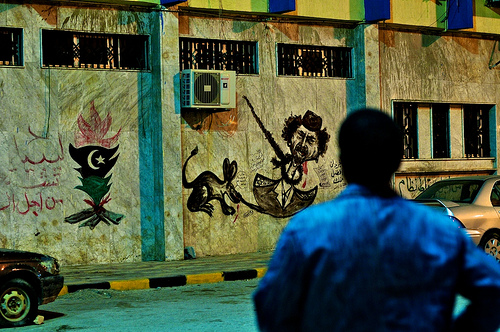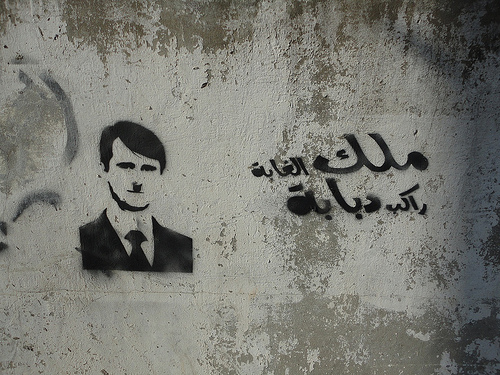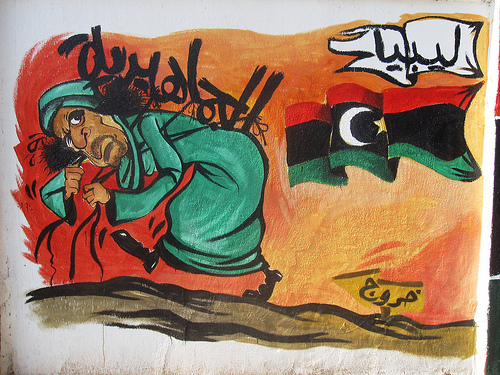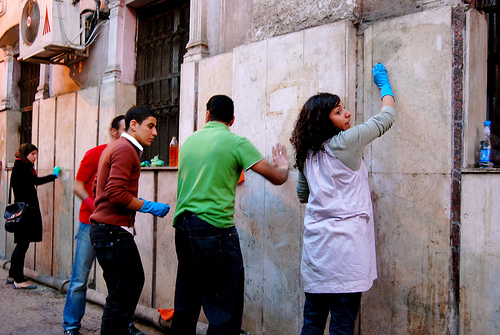“The words of the prophets were written on the subway walls and the tenement halls.”
– “Sounds of Silence,” Simon and Garfunkel
Amidst all the other messages spray-painted around Tahrir Square, calls to action and demands for ousted President Hosni Mubarak’s resignation last year, one military tank stuck out. “The revolution is in Tahrir,” it read, “no sleeping in bed.”
It was a common consensus amongst protesters, who rallied, and continue to speak out, to replace government corruption with reform, and despite sugar-coated concessions that underestimated a country’s intelligence by treating amendments like band-aids, that one thing was clear: the energy of the people refuses to wane. Instead, it continues to ceaselessly evolve as revolutionaries and reformers persistently provoke themselves and each other as creativity splinters through the cracks of worn-out censorship. In this sense, art fueled the revolution by giving the disenfranchised–the outsiders, the rebels, the refugees, the critics–a second draft to rewrite their country’s cultural memory.
Before the Arab Spring, authorities used public art as a means of propaganda, a projection of autocratic state power as status quo. Massive canvases depicting faces of the regime hung from buildings all throughout cities, staring down like Big Brother, like constant surveillance on any form of dissident activity. “This history of art is a sequence of successful transgressions,” wrote Susan Sontag. “Traditional art invites a look. Art that is silent engenders a stare.” Most of the time, these faces were accompanied by background images invoking nationalism or even Islam, suggesting what Joseph Campbell called “clues to the spiritual potentials of the human life.”
Pre-revolution, only presidential imagery was allowed in Tunisia’s public spaces. Last October, a giant poster of now-ousted president Ben Ali smiling appeared unexpectedly on the side of a building in the busy port city of La Goulette. A huge crowd surrounded it, and at their urging, a group of men pulled it down, only to reveal a second poster that read “Beware, dictatorship can return. On Oct 23, VOTE.” Elsewhere in the country, six photographers and a French graffiti artist began “INSIDE OUT,” a collaborative project that uses sticker art to promote democracy by replacing publicly displayed images of Ben Ali with black-and-white photos of anonymous Tunisian people.
This is where the hero myth starts, in these visual depictions of power that display leaders as men “who [have] found or done something beyond the normal range of achievement and experience” (Joseph Campbell). Typically their myth begins with some perceived injustice, or something lacking from society, so they embark on a journey to recover the missing piece that then restores the entire country to its unrealized glory. Sentiment is a very common theme in state propaganda art–the staged emotional love that the regime supposedly feels for the country it claims to have rescued. It plays out as nothing more than a metanarrative, that is, a story about a story to “give cultural practices some sort of legitimitation or authority” (Christopher Butler). Very rarely does this allow room for dispute.
In Syria, revolution sparked because of a tag, when fifteen young boys were arrested in March, 2011 for painting “The people want the fall of the regime” on a wall in the southern agricultural town of Daraa. Their detention and subsequent torture drove protesters to the streets, and the dominance of political graffiti nationwide from both rebels and Assad loyalists dubbed the country’s revolution the “war of the walls.”
After uprisings took hold of the Arab region, public art, in the form of graffiti, was not only subverted, it was also deconstructed. The narrative then shifts from myth to reality, primarily through the public’s denial of the possibility of any final or true validation of the regime. What history declared as fact suddenly found itself subject to review and reconstruction in spray paint on walls with graffiti, as Blake Gopnik wrote in Foreign Policy, working “as carrier of content and opinion… a true means of communication rather than as purely aesthetic exchange.”
It’s important to remember that artistic resistance is not a new Middle East phenomenon, and I refuse to describe its role in the 2011 uprisings as “a cultural renaissance,” because it wasn’t fueled by enlightenment, but rather public affirmation after decades of privatized dissent. Creativity as dissent in occupied and police state countries have been part of Middle East discourse for a very long time, in art, film, literature and music. Even graffiti has a deeply-rooted history with the Palestine wall, where it’s now seen as a rite of passage to spray-paint something in defiance of Israeli occupation. Yet for most Middle East countries, dissident art existed largely underground or through private mediums in that they protested politics through distribution. Street art on the other hand imposes itself into the public landscape. In this sense, Arabic graffiti did more than communicate; it empowered.
Between Arabic graffiti as communication and Arabic graffiti as empowerment lies Arabic graffiti as discourse, that is, the rewritten narrative that redefined art as establishment into art as resistance, by taking power away from a corrupt regime by breaking down the supposedly heroic myths that legitimized these dictatorships for so long. “Thinking about the place of art is not just a debate over the line that is drawn between local, national and global contexts,” Sontag once wrote. “It also involves an examination of the structures that confer authority and value to art… it is not only the place but also the authority of art that has undergone radical transformation.”
Perhaps no country makes better use of undermining the image of a president’s face than Libya, where Muammar Gaddafi is still the subject of most graffiti, much of which humorously depicts him as a rat, ape or vampire. One mural mocks his hair by calling it “barbed wire hair” while another satirizes his self-declaration “king of kings of Africa” by calling him the “monkey of monkeys of Africa.” Yet intermixed with Gaddafi as the butt of suppressed jokes are other serious, introspective pieces that look at themes of war, nationalism and the still uncertain future for Libya.
While graffiti did get political messages out without using the rhetoric of ideology, it also served as a way to dismantle a dictator’s hero myths by imagining the possibility of a future without him, a reflection of the resilience of the Revolution’s spirit. In Egypt, artists commemorated the anniversary of the violent March 9 army-led clearing during a Tahrir sit-in by reclaiming seven walls built by the Egyptian military to block central Cairo from the Ministry of the Interior. The walls are essentially stone cubes stacked atop each other with wires running across the top to prevent people from climbing over. “Art is the only weapon we have left to deal with the military dictatorship,” street artist Ganzeer said last January. In that spirit, the “No Walls” project launched on March 9, 2012 to transform all seven walls into virtual open spaces with painted landscapes. The goal: “re-open the blocked streets by making the walls invisible.” The themes reflect the attitudes of each individual artist, from mockery and irony to commemorating those killed in the protests and creating a memorial space for the revolution. On Mansour Street, there is “Tomorrow” by graffiti artist Zeft, depicting a vibrant rainbow over silhouettes of children playing in the park. Its message: hope in the face of violence and the depression of reality. On Farid Street, where the wall directly faces the Ministry of the Interior, is a painting depicting the rest of the street with a Handala figure holding his sword up to the building– in essence, breaking the physical barrier that Egyptians can’t cross to confront the Military’s corrupt rule. The wall on Falaki Street is simple: portholes of a boat, as if the wall were a window to the open sea.
“A drawing on the street is similar to a letter,” said Tehran graffiti artist A1one, “it proves that there is a writer.” Nowhere is this more apparent than on the streets of Revolution itself, its canvas spray-painted, then whitewashed, only to be tagged again. This has been the dialogue between a reclaimed public and an incomplete reform. Just as rap became the soundtrack to the Arab Spring, graffiti was its canvas, an open-ended graphic novel of sorts, an illustrated history where the silenced could finally articulate their voices, their situations, their identities. With antecedents dating back to the Iranian Revolution of 1979, the first Intifada in 1987 and the civil war in Lebanon, political graffiti re-emerged at the onset of the Arab Spring as both the first and the most common form of expression–a fusion of street art, urban culture and the written word–allowing protesters and artists alike to physically take back ownership and fill a void where authorities fell short in honoring the dead, holding perpetrators accountable, demanding justice, and restoring normalcy.








